Lyons W.C. (ed.). Standard handbook of petroleum and natural gas engineering.2001- Volume 1
Подождите немного. Документ загружается.

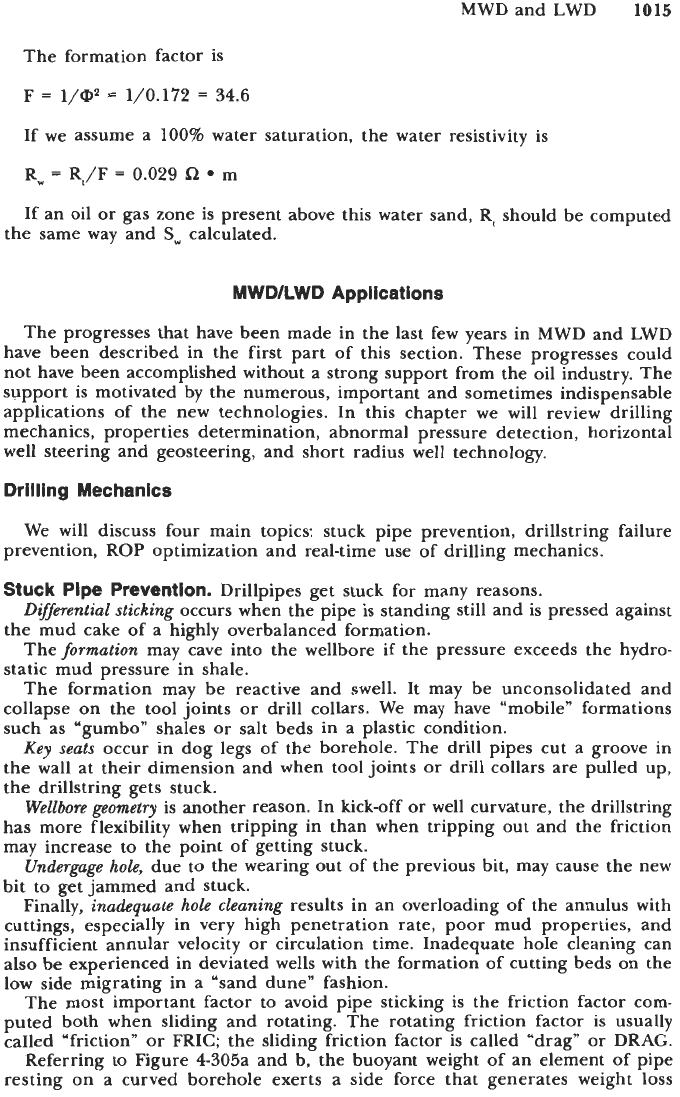
MWD and LWD
1015
The formation factor is
F
=
l/W
=
1/0.172
=
34.6
If we assume a
100%
water saturation, the water resistivity
is
R,
=
R,/F
=
0.029
C2
m
If an oil
or
gas zone
is
present above this water sand, Rt should be computed
the same way and
Sw
calculated.
MWDILWD Applications
The progresses that have been made in the last few years in MWD and LWD
have been described in the first part of this section. These progresses could
not have been accomplished without a strong support from the oil industry. The
support is motivated by the numerous, important and sometimes indispensable
applications of the new technologies. In this chapter we will review drilling
mechanics, properties determination, abnormal pressure detection, horizontal
well
steering and geosteering, and short radius well technology.
Drilling Mechanics
We will discuss four main topics: stuck pipe prevention, drillstring failure
prevention, ROP optimization and real-time use of drilling mechanics.
Stuck
Pipe Prevention.
Drillpipes get stuck for many reasons.
Dgfmential sticking
occurs when the pipe is standing still and is pressed against
the mud cake of a highly overbalanced formation.
Theformation
may cave into the wellbore if the pressure exceeds the hydro-
static mud pressure in shale.
The formation may be reactive and swell. It may be unconsolidated and
collapse on the tool joints
or
drill collars. We may have “mobile” formations
such as “gumbo” shales
or
salt beds in a plastic condition.
Key seats
occur in dog legs of the borehole. The drill pipes cut a groove in
the wall at their dimension and when tool joints
or
drill collars are pulled up,
the drillstring gets stuck.
Wellbore geometry
is another reason. In kick-off
or
well curvature, the drillstring
has more flexibility when tripping in than when tripping out and the friction
may increase to the point of getting stuck.
Undergage hole,
due to the wearing out of the previous bit, may cause the new
bit
to
get jammed and stuck.
Finally,
inadequate hole cleaning
results in an overloading of the annulus with
cuttings, especially in very high penetration rate, poor mud properties, and
insufficient annular velocity or circulation time. Inadequate hole cleaning can
also be experienced in deviated wells with the formation of cutting beds on the
low side migrating in a “sand dune” fashion.
The most important factor to avoid pipe sticking is the friction factor com-
puted both when sliding and rotating. The rotating friction factor is usually
called “friction”
or
FRIC; the sliding friction factor is called “drag”
or
DRAG.
Referring to Figure 4-305a and b, the buoyant weight of an element of pipe
resting on a curved borehole exerts a side force that generates weight
loss
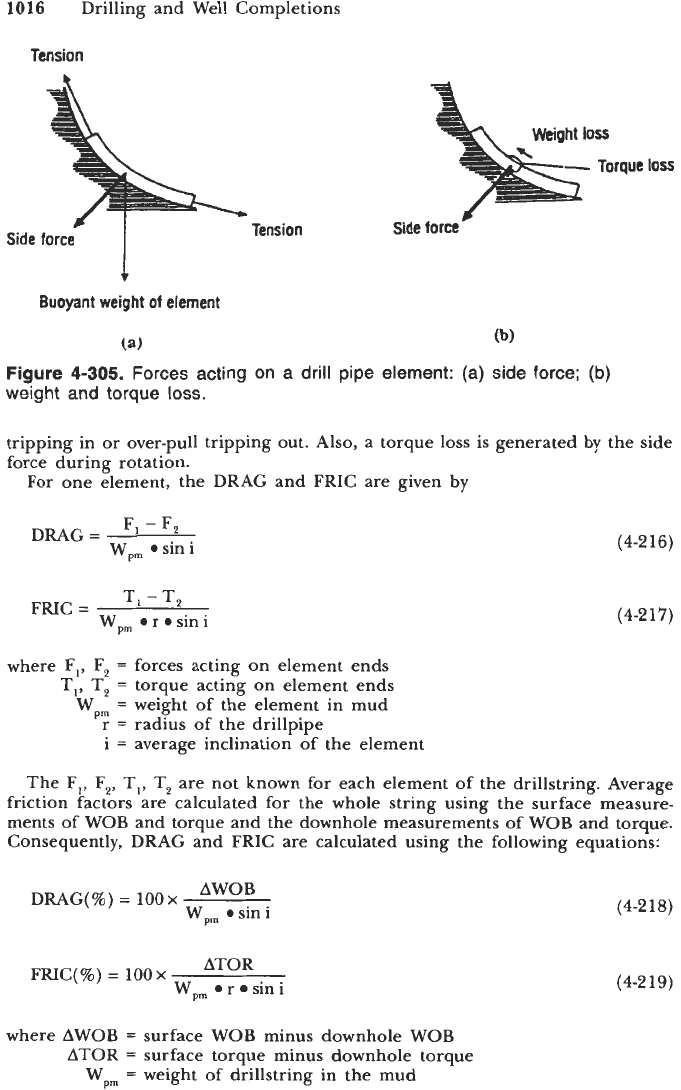
1016
Drilling and Well Completions
Tension
b
1
Buoyant
weight
of element
fl
Side force
Figure
4-305.
Forces acting on a drill pipe element: (a) side force;
(b)
weight
and
torque
loss.
tripping in or over-pull tripping out. Also, a torque loss is generated
by
the side
force during rotation.
For one element, the DRAG and FRIC are given by
F,
-
F2
DRAG
=
W,, sin i
TL
-T,
FRIC
=
W,,
er
*sini
where
F,,
F,
=
forces acting on element ends
T,,
T,
=
torque acting on element ends
Wpm
=
weight of the element in mud
r
=
radius of the drillpipe
i
=
average inclination of the element
(4-2
16)
(4-2
17)
The
F,,
F,,
TI,
T, are not known for each element of the drillstring. Average
friction factors are calculated for the whole string using the surface measure-
ments of WOB and torque and the downhole measurements of WOB and torque.
Consequently, DRAG and FRIC are calculated using the following equations:
AWOB
W,,
e
sin i
DRAG(%)
=
100
x
ATOR
W,,
r sin
i
FRIC(%)
=
100
x
(4-2
18)
(4-219)
where AWOB
=
surface WOB minus downhole WOB
ATOR
=
surface torque minus downhole torque
Wpm
=
weight of drillstring in the mud
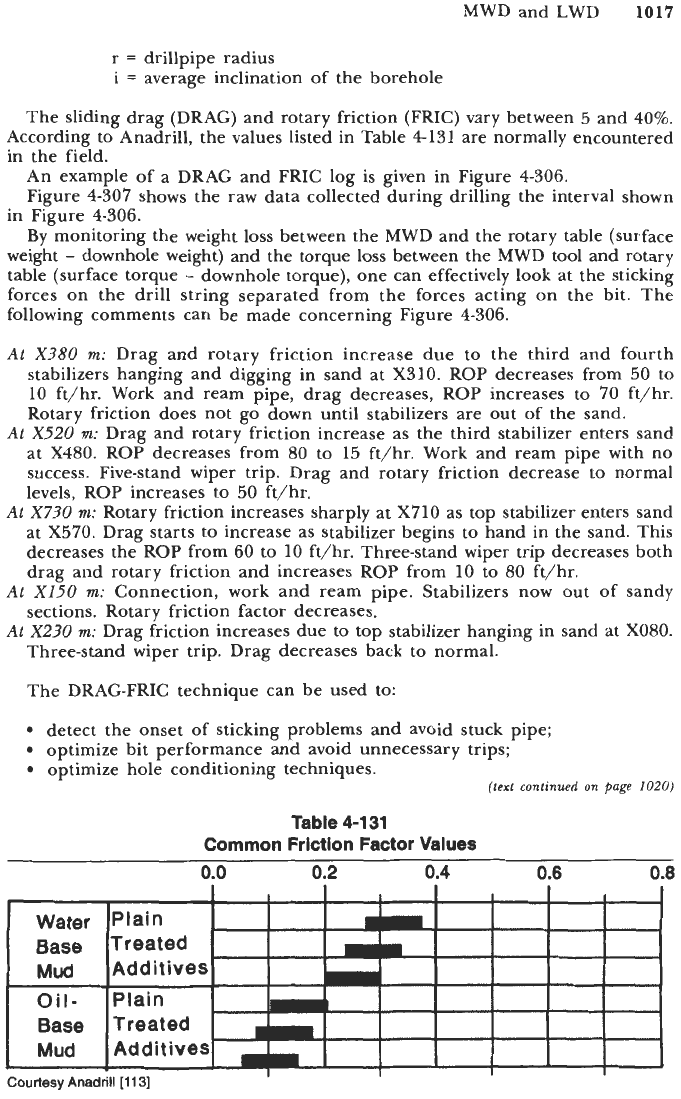
MWD and LWD
1017
r
=
drillpipe radius
i
=
average inclination of the borehole
The sliding drag (DRAG) and rotary friction (FRIC) vary between
5
and
40%.
According to Anadrill, the values listed in Table
4-131
are normally encountered
in the field.
An example of a DRAG and FRIC log is given in Figure
4-306.
Figure
4-307
shows the raw data collected during drilling the interval shown
in Figure
4-306.
By monitoring the weight loss between the MWD and the rotary table (surface
weight
-
downhole weight) and the torque
loss
between the
MWD
tool and rotary
table (surface torque
-
downhole torque), one can effectively look at the sticking
forces on the drill string separated from the forces acting on the bit. The
following comments can be made concerning Figure
4-306.
At
X380
m:
Drag and rotary friction increase due to the third and fourth
stabilizers hanging and digging in sand at
X310.
ROP decreases from
50
to
10
ft/hr. Work and ream pipe, drag decreases, ROP increases to
70
ft/hr.
Rotary friction does not go down until stabilizers are out of the sand.
At
X520
m:
Drag and rotary friction increase as the third stabilizer enters sand
at
X480.
ROP decreases from
80
to
15
ft/hr. Work and ream pipe with no
success. Five-stand wiper trip. Drag and rotary friction decrease to normal
levels, ROP increases to
50
ft/hr.
At
X730
m:
Rotary friction increases sharply at
X710
as top stabilizer enters sand
at
X570.
Drag starts to increase as stabilizer begins to hand in the sand. This
decreases the ROP from
60
to
10
ft/hr. Three-stand wiper trip decreases both
drag and rotary friction and increases
ROP
from
10
to
80
ft/hr.
At
X150
m:
Connection, work and ream pipe. Stabilizers now out of sandy
sections. Rotary friction factor decreases.
At
X230
m:
Drag friction increases due to top stabilizer hanging in sand at
X080.
Three-stand wiper trip. Drag decreases back to normal.
The DRAG-FRIC technique can be used to:
detect the onset of sticking problems and avoid stuck pipe;
optimize bit performance and avoid unnecessary trips;
optimize hole conditioning techniques.
(text
continued on
page
1020)
Table
4-1
31
Common Friction Factor
Values
0.0
0.2
0.4
0.6
0.8
I
I
I
I
Courtesy
Anadrill
[
11
31
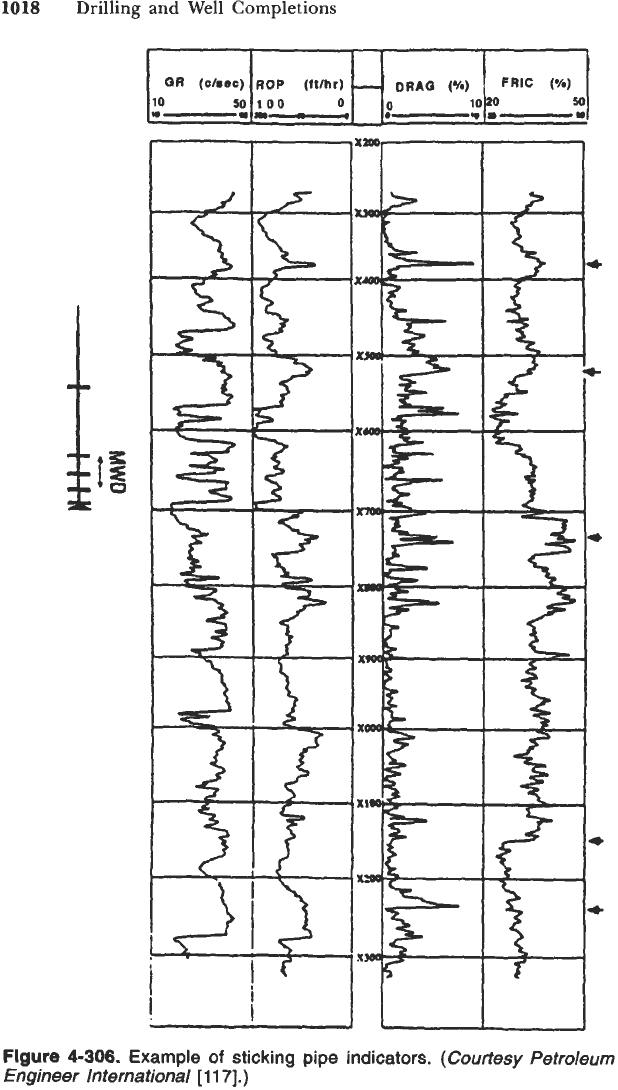
1018
Drilling and
Well
Completions
Figure
4-306.
Example
of
sticking pipe indicators.
(Courtesy Petroleum
Engineer lnternational
[
11
71.)

MWD
and
LWD
1019
Figure
Figure
4-307.
Raw data used for computing the log represented
in
4-306.
(Courtesy Petroleum Engineer lnternational
[
11
71.)

1020
Drilling and Well Completions
(text
continued
from
page
101
7)
Drillstring Failure Prevention.
Drillstring failures are mainly due to vibrations,
shocks and neutral point positioned too close to the drill pipes. They result in
drillstring washouts and twist-offs.
Axial vibrations
usually occur in vertical boreholes and hard rock drilling with
tricone bits. They can cause top drive shaking, Kelly bouncing, and induce
downhole shocks. Axial vibrations can be minimized by changing the WOB and
rotary
RPM
after rotation comes to a complete stop. Change the bit type may
also help.
Lateral vibrations
result from the coupling with axial mode of buckling. The
lateral vibrations may also result from a coupling with the torsional vibrations.
Torsional vibrations
are due to the “stick-slip” effect of the stabilizers in
deviated boreholes. They can be seen at surface as large torque oscillations with
a period of
3
to
10
s.
Figure
4-308
shows a near-bit stabilizer in a deviated
borehole. The stick-slip effect increases with WOB and
RPM.
A
torque feedback system has been developed to dampen the surface torque
oscillations and consequently the stick-slip motion at the bit. The system consists
of (see Figure
4-309)
motor current sensor
shaft encoder coupled to the rotary drive motor
microprocessor
on/off switch for the driller to activate the feedback system
The system of Figure
4-309
reduces drillstring vibrations by
90%.
Note that
when deactivating the system, several minutes elapse before the vibrations start
again. Similarly, when the system is turned on, several minutes will elapse before
the vibrations are dampened.
The
lateral
shocks,
the most damaging for the MWD/LWD equipment, are more
severe in vertical holes than in horizontal holes. In a vertical hole, the collars
or
stabilizers hit the borehole wall hard because the gravity does not pull the
collar on the low side as in deviated or horizontal boreholes.
RPM
v
Figure
4-308.
Stick-slip effect due to near-bit fraction in a deviated borehole.
(Courtesy
Anadrill
[113].)
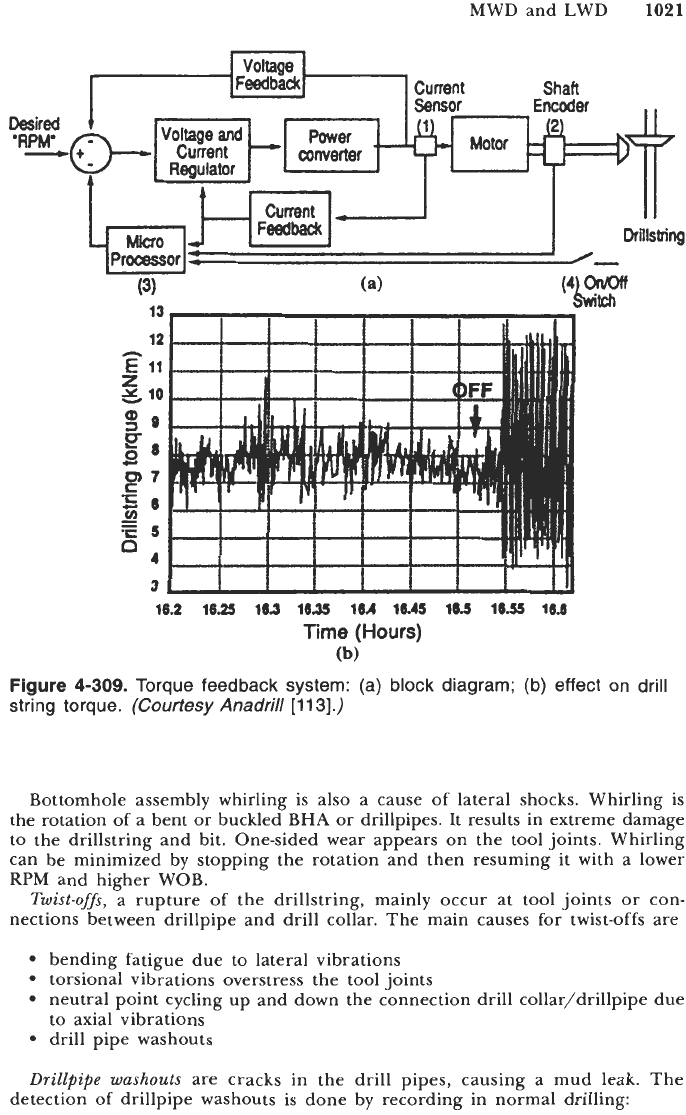
MWD and LWD
1021
18.2
11.2)
113
16x1
IIA
la45
16s
11.u
16.1
Time
(Hours)
(b)
Figure
4-309.
Torque feedback system: (a) block diagram; (b) effect on drill
string torque.
(Courtesy
Anadrill
[113].)
Bottomhole assembly whirling is also a cause of lateral shocks. Whirling is
the rotation of a bent or buckled BHA or drillpipes. It results in extreme damage
to the drillstring and bit. One-sided wear appears on the tool joints. Whirling
can be minimized by stopping the rotation and then resuming it with a lower
RPM and higher WOB.
Twist-offs,
a rupture of the drillstring, mainly occur at tool joints or con-
nections between drillpipe and drill collar. The main causes for twist-offs are
bending fatigue due to lateral vibrations
torsional vibrations overstress the tool joints
neutral point cycling up and down the connection drill collar/drillpipe due
to axial vibrations
drill pipe washouts
Drillpipe
washouts
are cracks in the drill pipes, causing a mud leak. The
detection of drillpipe washouts is done by recording in normal drilling:
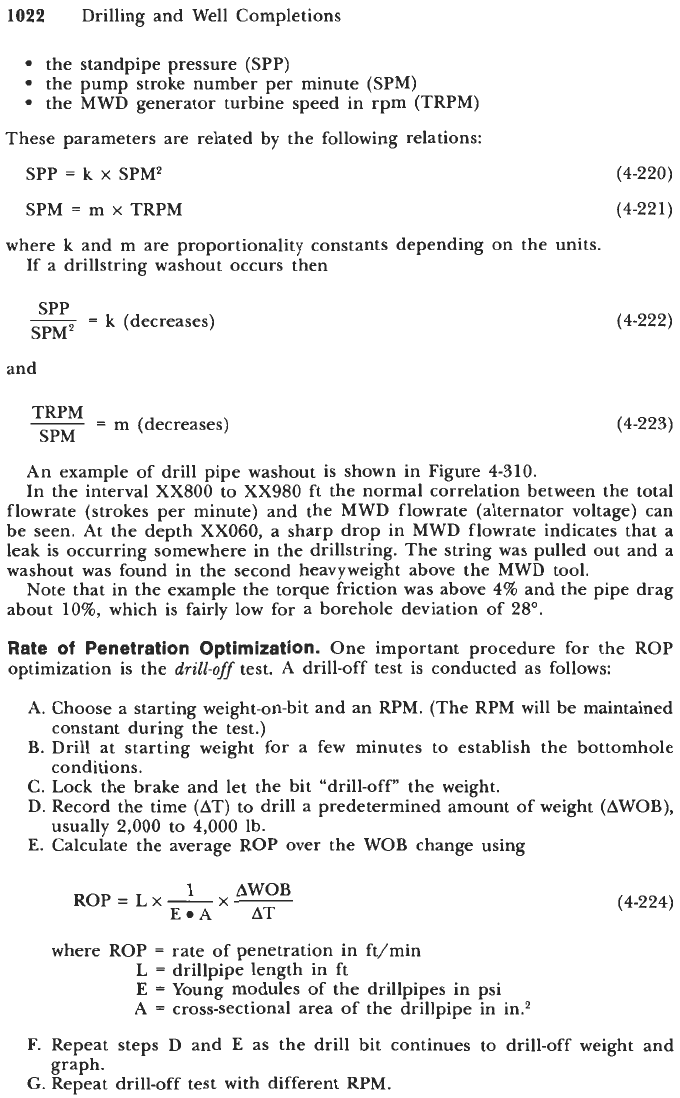
1022
Drilling and Well Completions
the standpipe pressure (SPP)
the pump stroke number per minute (SPM)
the MWD generator turbine speed in rpm (TRPM)
These parameters are related by the following relations:
SPP
=
k
x
SPM2
SPM
=
m
x
TRPM
(4-220)
(4-22
1)
where
k
and m are proportionality constants depending on the units.
If a drillstring washout occurs then
spp
=
k
(decreases)
(4-222)
SPM2
and
=
m
(decreases)
TRPM
SPM
(4-223)
An example of drill pipe washout is shown in Figure
4-310.
In the interval
XX800
to
XX980
ft the normal correlation between the total
flowrate (strokes per minute) and the MWD flowrate (alternator voltage) can
be seen. At the depth
XX060,
a sharp drop in MWD flowrate indicates that a
leak is occurring somewhere in the drillstring. The string was pulled out and a
washout was found in the second heavyweight above the MWD tool.
Note that in the example the torque friction was above
4%
and the pipe drag
about
lo%,
which is fairly low for a borehole deviation of
28".
Rate
of
Penetration Optimization.
One important procedure for the ROP
optimization is the
drill-off
test. A drill-off test is conducted as follows:
A.
Choose a starting weight-on-bit and an RPM. (The RPM will be maintained
B. Drill at starting weight for a few minutes to establish the bottomhole
C. Lock the brake and let the bit "drill-off" the weight.
D. Record the time (AT) to drill a predetermined amount of weight (AWOB),
E.
Calculate the average ROP over the WOB change using
constant during the test.)
conditions.
usually
2,000
to
4,000
lb.
1
AWOB
ROP=LX-X-
E.A
AT
(4-224)
where ROP
=
rate of penetration in ft/min
L
=
drillpipe length in ft
E
=
Young modules of the drillpipes in psi
A
=
cross-sectional area
of
the drillpipe in in.*
F. Repeat steps D and
E
as the drill bit continues to drill-off weight and
G.
Repeat drill-off test with different RPM.
graph.
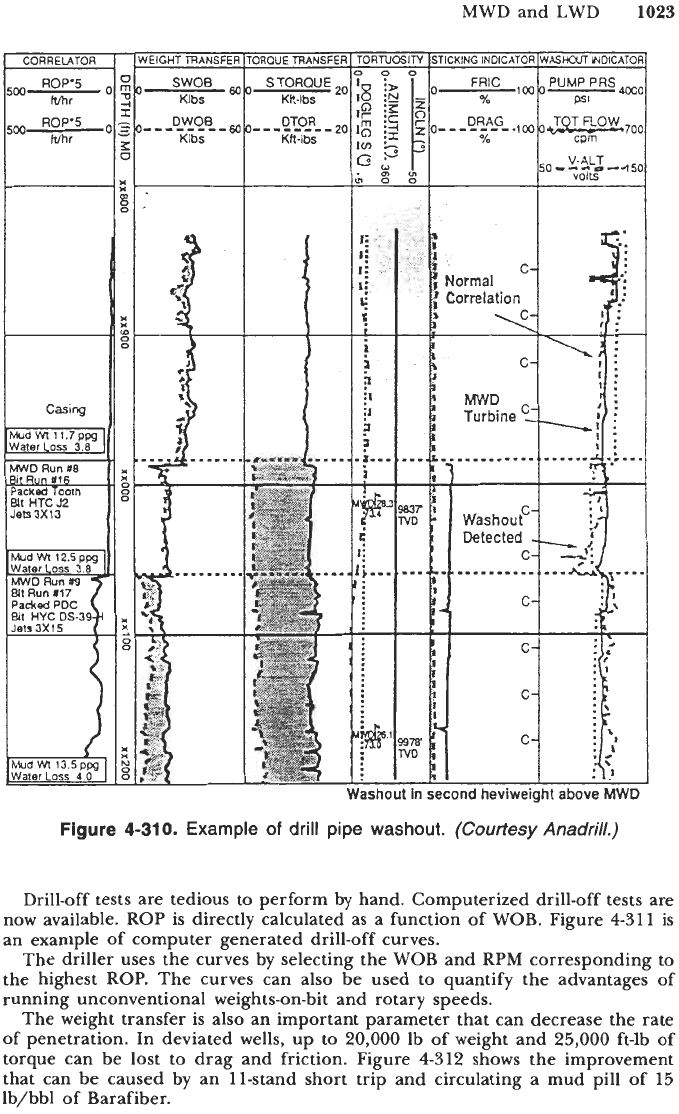
MWD and LWD
1023
Figure
4-310.
Example
of
drill pipe
washout.
(Courtesy
Anadrill..)
Drill-off tests are tedious to perform by hand. Computerized drill-off tests are
now available. ROP is directly calculated as a function of WOB. Figure 4-311 is
an example of computer generated drill-off curves.
The driller uses the curves by selecting the
WOB
and RPM corresponding to
the highest ROP. The curves can also be used to quantify the advantages of
running unconventional weights-on-bit and rotary speeds.
The weight transfer is also an important parameter that can decrease the rate
of penetration. In deviated wells, up to 20,000 lb of weight and 25,000 ft-lb of
torque can be lost to drag and friction. Figure 4-312 shows the improvement
that can be caused by an 11-stand short trip and circulating a mud pill of 15
lb/bbl of Barafiber.
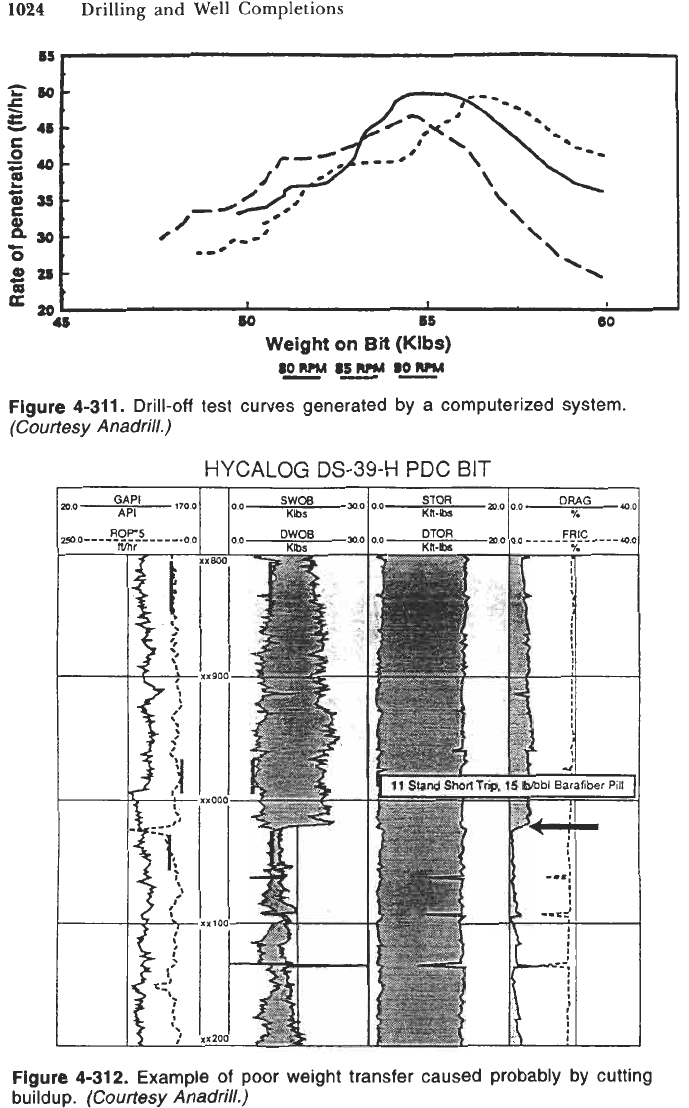
1024
Drilling and Well Completions
60
65
Weight
on
Bit
(Klbs)
8OWM
85WM
#Om
60
Figure
4-311.
Drill-off test curves generated by a computerized system.
(Courtesy
Anadrill.)
Figure
4-312.
Example of poor weight transfer caused probably
by
cutting
bu i Idu p
.
(Courtesy
Anadrill.)
